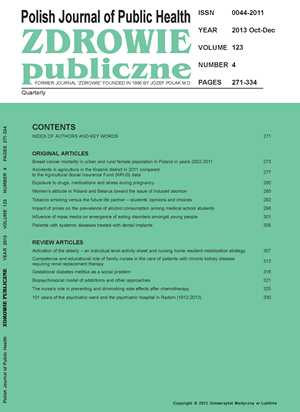Biopsychosocial model of addictions and other approaches
DOI:
https://doi.org/10.12923/j.0044-2011/123-4/a.12Keywords:
biopsychosocial model, addictions, classifications of mental disordersAbstract
Preparing the 5th Edition of Diagnostic Manual of Mental Disorders provokes the experts to express their opinions concerning the new classification of the psychiatric disorders. It takes into account also addictions. For some time the discussion concerning behavioral forms of addictions and their position in new revisions of both international classifications of mental disorders has taken place. The American Society of Addiction Medicine expressed the opinion concerning the new definition of addictions stressing relevance of biological mechanisms – mainly the brain reward, motivation, memory and related circuitry, and also genetic and envoirmental factors. The new definition of addictions is congruent with biopsychosocial model of addictions, which has revolutionized the DSM III. In this article the history and basic assumptions of biopsychosocial approach, and other theories that were precursors to this model are recalled.
References
1. Definition of addiction. American Society of Addiction Medicine. The Voice of Addiction Medicine. [http://www.asam.org/research-treatment/definition-of-addiction]
2. Diagnostic and statistical manual of mental disorders (4th ed., text rev). Washington: American Psychiatric Association; 2000.
3. Kaplan DM, Coogan SL. The next advancement in counseling: the bio-psycho-social model VISTAS Online. American Counseling Asso¬ciation; 2005. p. 17-25. [http://counselingoutfitters.com/vistas/vistas05/Vistas05.art03.pdf]
4. Kurnpfer KL, Trunnell EP, Whiteside HO. The biopsychosocial model: application to the addictions field. In: RC. Engs (ed). Controversies in the addiction’s field. Dubuque: Kendal-Hunt; 1990. p. 55-67. [http://www.indiana.edu/~engs/cbook/tabcont.html]
5. The biopsychological theory: a comprehensive descriptive perspective on addiction. Alcohol and drug services. Adult Addictions Services Branch. Alcohol and Drug Services British Columbia Ministry for Chil¬dren and Families, 1996. [http://citeseerx.ist.psu.edu/viewdoc/download;jsessionid=4ECC3F44D969868215F5BDC376122864?doi=10.1.1.89.1099&rep=rep1&type=pdf]
6. Masiak M. Personality and social group structure, function and gender in terms of transactional analysis. In: C. Wheatley, RP. Badillo, RB Calabretta, R. Magliola. Humanization of Social Life. Vol. 1. Theory and Challenges. Washington: Council for Research in Values and Phi¬losophy; 2004. p. 287-98. [http://books.google.pl/books?id=g1Ehj_KvVoYC&pg=PA287&lpg=PA287&dq=Personality,+Social+Groups+Structure,+Functioning+and+Transfer+in+Terms+of+Transactional+Analysis&source=bl&ots=J9LomFrPvm&sig=jMlkgukJ4uAQCAhdFxjJn3OKJrY&hl=pl&sa=X&ei=-aD6T7DNG8qi0QX7m-yhBw&ved=0CFsQ6AEwAg#v=onepage&q=Personality%2C%20So-cial%20Groups%20Structure%2C%20Functioning%20and%20Trans-fer%20in%20Terms%20of%20Transactional%20Analysis&f=false]
7. Lende DH, Smith EO. Evolution meets biopsychosociality: an analysis of addictive behavior. Addiction. 2002;97(4):447-58.


